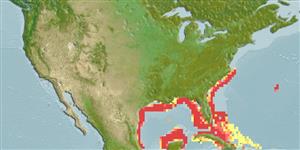>
Lophiiformes (Anglerfishes) >
Ogcocephalidae (Batfishes)
Etymology: Ogcocephalus: Greek, ogkos, ou = hook, curvature (Ref. 45335); corniger: From the long, upturned rostrum (corniger = horn-bearer) (Ref. 40824).
Environment: milieu / climate zone / depth range / distribution range
Ecologia
marino demersale; distribuzione batimetrica 29 - 230 m (Ref. 40824). Subtropical; 37°N - 20°N
Western Atlantic: North Carolina and northern Gulf of Mexico in USA to southern Bahamas.
Size / Peso / Age
Maturity: Lm ? range ? - ? cm
Max length : 23.0 cm TL maschio/sesso non determinato; (Ref. 7251)
Short description
Chiavi di identificazione | Morfologia | Morfometria
Evenly covered by closely set pale spots on a darker background. Subopercular lateral-line scales usually 5-7. Differs from pumilus in having larger body size and fleshy pads on the ventral tips of the pectoral rays (absent in pumilus) (Ref. 40824).
Found typically on sandy bottoms (Ref. 27549).
Life cycle and mating behavior
Maturities | Riproduzione | Spawnings | Egg(s) | Fecundities | Larve
Bradbury, M.G., 1980. A revision of the fish genus Ogcocephalus with descriptions of new species from the western Atlantic Ocean (Ogcocephalidae: Lophiiformes). Proc. Calif. Acad. Sci. 42(7):229-285. (Ref. 40824)
IUCN Red List Status (Ref. 130435)
Threat to humans
Harmless
Human uses
Strumenti
Special reports
Download XML
Fonti Internet
Estimates based on models
Preferred temperature (Ref.
123201): 18.3 - 27.4, mean 23.5 °C (based on 69 cells).
Phylogenetic diversity index (Ref.
82804): PD
50 = 0.5001 [Uniqueness, from 0.5 = low to 2.0 = high].
Bayesian length-weight: a=0.02291 (0.00925 - 0.05675), b=2.94 (2.72 - 3.16), in cm total length, based on LWR estimates for this (Sub)family-body shape (Ref.
93245).
Trophic level (Ref.
69278): 3.4 ±0.6 se; based on size and trophs of closest relatives
Resilienza (Ref.
120179): Medio, tempo minimo di raddoppiamento della popolazione 1.4 - 4.4 anni (Preliminary K or Fecundity.).
Fishing Vulnerability (Ref.
59153): Low vulnerability (13 of 100).
